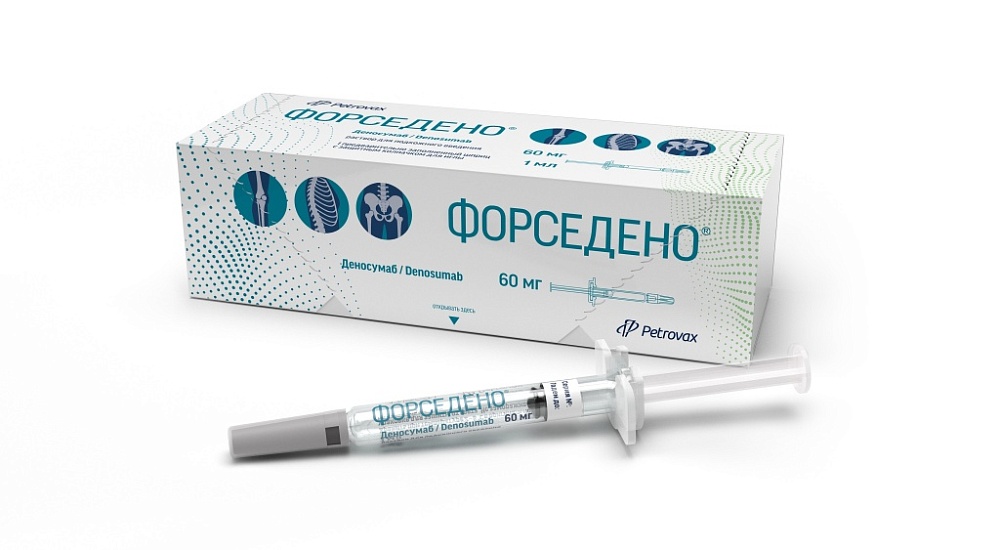
The first-ever biosimilar of original medicine for osteoporosis treatment has been approved in the Russian Federation

The medicine will make the cutting-edge treatment more affordable for millions of Russians
Moscow, April 2025. — The Ministry of Health of Russia has granted marketing authorization for Forsedeno® (INN denosumab), the country’s first-ever biosimilar of the original targeted medicine used to treat osteoporosis. This average prevalence of this condition in Russia is 30% among subjects aged above 50 years. Petrovax Pharm is launching Forsedeno® in the Russian market and intends to supply the biosimilar at a lower price compared to the cost of a medicine containing the same active ingredient.
Osteoporosis is often called a «silent epidemic» because it can progress undetected for a long time. 14 million people in Russia suffer from osteoporosis[1], including 34% of women and 27% of men over 50 years of age[2], but the disease can occur in younger people. The disease destroys bone tissue and can result in severe fractures, loss of mobility and disability[2]. Treating osteoporosis with different medications, including denosumab, can increase bone mineral density and significantly reduce the risk of fractures[2].
Denosumab is a complete monoclonal human antibody that inhibits the RANKL activator receptor and prevents bone tissue degradation[2].
The rights to denosumab biosimilar in Russia were acquired by Petrovax Pharm based on a licensing agreement with AryoGen Pharmed (part of CinnaGen Group), outlining a subsequent full localization of production facilities. Comparable clinical efficacy of the denosumab biosimilar compared to the reference medicine Prolia was confirmed in a phase 3 multicenter, double-blind, randomized clinical study[3]. More than 50,000 osteoporosis patients have already received successful therapy with the biosimilar.
Reference information
Forsedeno® (INN denosumab) is a protein and essentially a complete human monoclonal antibody that inhibits the activity of RANKL (receptor activator of nuclear factor kappa-beta ligand), a key molecule in the formation of osteoclast — cells responsible for resorbing bone tissue during bone metabolism by dissolving its mineral component[3]. By blocking the activity of this protein, denosumab inhibits osteoclast formation, function and survival and thus reduces the intensity of bone resorption (degradation). This results in a rapid increase in bone mass in all parts of the skeleton and a decreased risk of vertebral and non-vertebral fractures.
The medicine Forsedeno® is available in prefilled syringes and is used to treat
— osteoporosis in postmenopausal women (postmenopausal osteoporosis) and osteoporosis in men at an increased risk of bone fractures;
— loss of bone mass due to decreased concentrations of testosterone due to surgery or the use of medicine products in men with prostate cancer;
— bone mass loss associated with long-term systemic glucocorticosteroid therapy in adult patients at an increased risk of fracture.
CinnaGen is an Iranian Group that has been manufacturing biosimilars since 1994. It exports its products to more than 40 countries. CinnaGen has achieved remarkable success in the Middle East and North African markets. Exports are also intended for Eastern Europe, South-East Asia, and Latin America. CinnaGen has been supplying its biopharmaceutical products to Russia for more than 10 years, since 2011. The company holds a Good Manufacturing Practice (GMP) certificate from the European Medicines Agency (EMA). AryoGen Pharmed, an Iranian pharmaceutical company, is part of CinnaGen Group. It focuses on the production of biopharmaceutical products that meet global standards.
1Clinical Guidelines of the Ministry of Health of Russia "Osteoporosis". https://cr.minzdrav.gov.ru/preview-cr/87_4
2Zh.E. Belaya, L. Ya. Rozhinskaya. New directions in the treatment of osteoporosis – the use of monoclonal human antibodies to RANKL (Denosumab) // Osteoporosis and Bone Diseases – 2011. – Vol. 14. – No.2. – P. 23-26.
3Jamshidi et al. Arthritis Research & Therapy (2022) 24:161 https://doi.org/10.1186/s13075-022-02840-8

